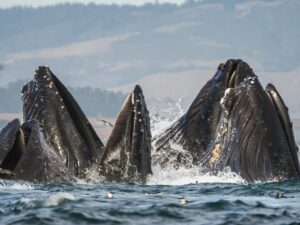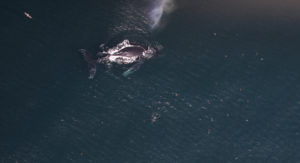In mid-November, a federal judge gave the U.S. Navy permission to test its Low-Frequency Array (LFA) sonar in the western Pacific Ocean. The system transmits sounds up to 215 decibels, approximately equivalent to the noise of an F-15 fighter jet during takeoff.
Environmental groups have sought to stop the Navy, fearing that whales in the Pacific will suffer a fate similar to that of 17 whales and dolphins in the Bahamas in March, 2000. According to a report published by the Department of Commerce and the Navy, seven cetaceans died from heart failure, and an additional 10 were injured, due to extreme acoustic trauma caused by sonar transmitted during a naval exercise. The tactical mid-frequency sonar used in the Bahamas transmits at levels similar to those of the LFA.
Will high-volume sonar affect California’s gray whale populations? Sonar testing typically occurs in pelagic (deep ocean) areas, where the Navy is searching for submarines, while gray whales generally stay in coastal waters. Researchers are therefore cautiously optimistic that the Navy’s new system will not have an impact on the Eastern Pacific stock of gray whales. However, they caution, limited tests have demonstrated gray whales’ aversion to these high-volume sounds, and it is much too early to rule out damaging long-term effects. And, of course, scientists and advocacy groups continue to express concern about sonar’s impact on pelagic whale species, such as beaked, humpback, and blue whales.
UPDATE:
On January 8, 2003, a federal judge placed a temporary restraining order on researchers from the Woods Hole Oceanographic Institute and Scientific Solutions, Inc., preventing them from proceeding with high-frequency sonar tests in California coastal waters near Santa Barbara. The tests, which were approved by the National Marine Fisheries Service in 2002, would determine whether prototype sonar systems could successfully locate migrating gray whales. Such systems could eventually be used to prevent ocean vessels from bumping into whales and to warn oil and gas explorers, who detonate undersea explosives, of the presence of nearby whales and other marine mammals.
Groups such as the Channel Islands Animal Protection Association (CIAPA) and other environmental and animal welfare organizations that brought Woods Hole and Scientific Solutions to court over the issue wonder how the testing would affect gray whales. CIAPA attorney Lanny Sinkin expressed concern that the high-frequency pulses could disorient the whales, causing them to swerve from their migratory paths and causing calves to become separated from their mothers. Shelly Dawicki, spokeswoman for Woods Hole, suggests that the tests are needed to determine exactly how sonar affects gray whales.
The judge will hear arguments on the case on January 17, 2003.




